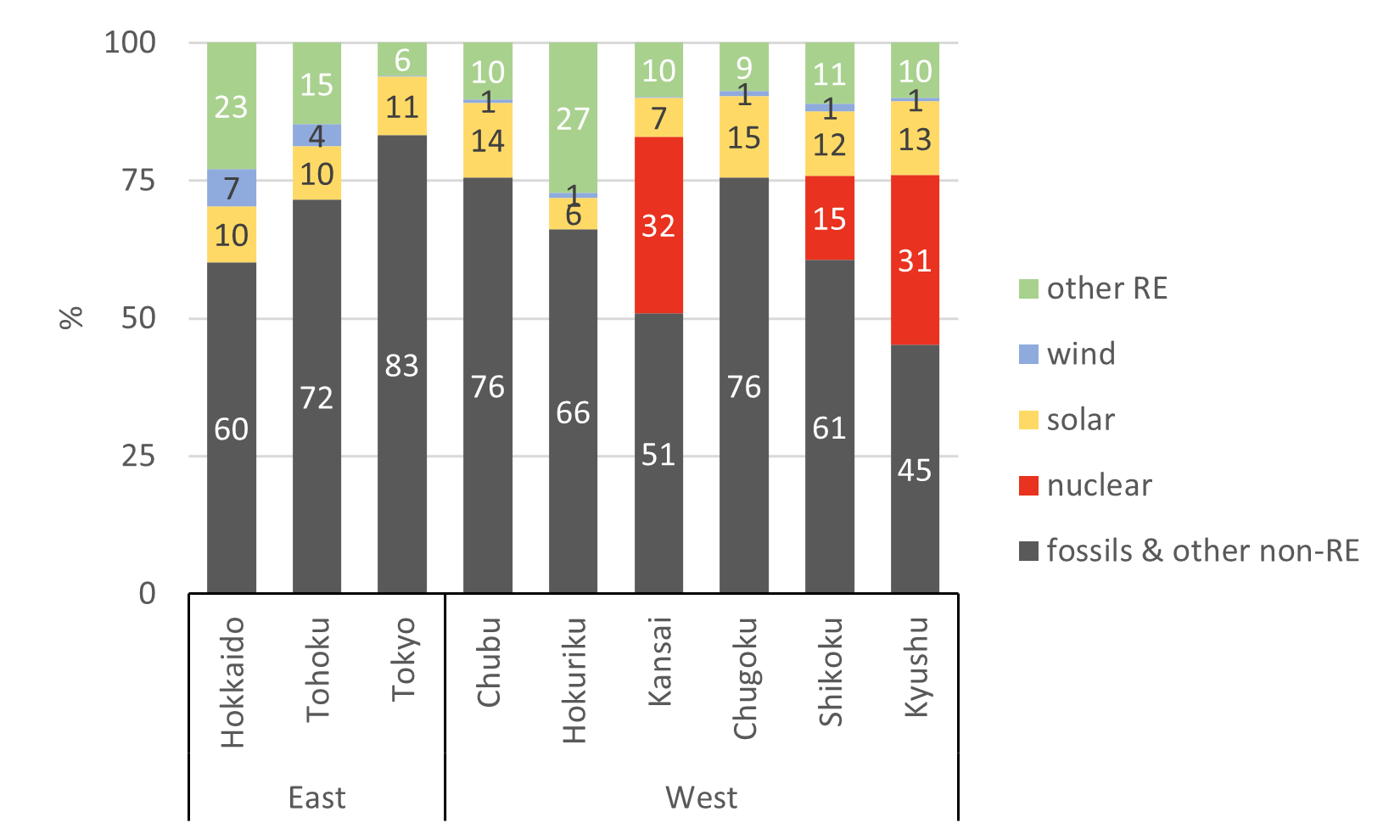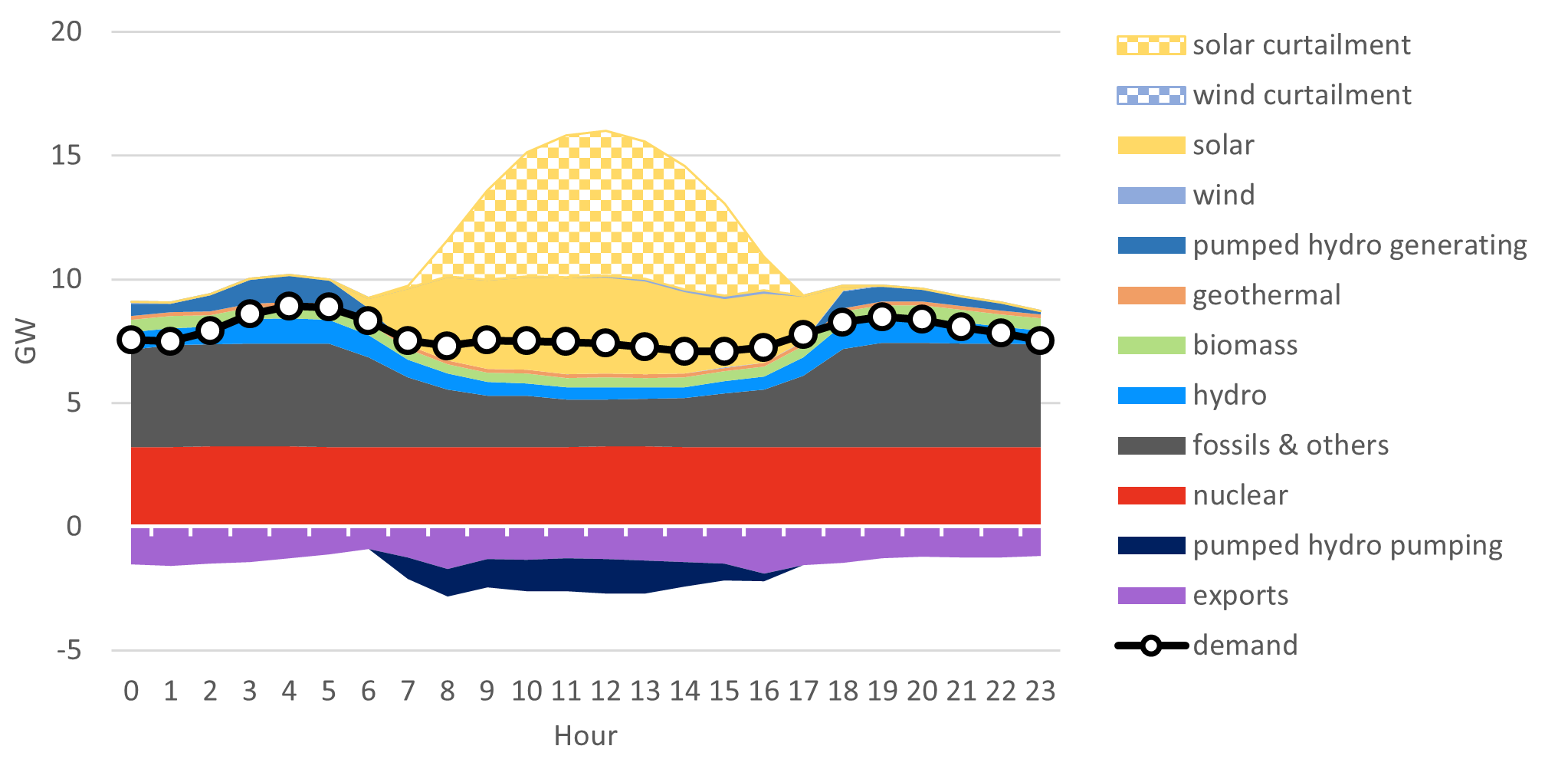|
Curtailment is a failure to consume or store close to zero marginal cost decarbonized electricity from solar & wind power. Therefore, it should be minimized on economic and environmental grounds. In Japan in fiscal year 2023, curtailment is forecasted to significantly increase and reach a new record of 1.76 terawatt-hour. Until fiscal year 2021 curtailment was limited to Kyushu. Except for Tokyo, curtailment is now affecting all the power systems of the country. The situation has become particularly problematic in Kyushu where the curtailment rate of solar + wind power was projected to reach nearly 7% in fiscal year 2023. This rate is more than double those in Australia and California, two power systems successfully integrating shares of solar + wind in their electricity consumption twice greater than Kyushu. On a positive note, it is possible to rapidly reduce curtailment in Japan by prioritizing the implementation of two key regulatory solutions: economic dispatch and negative prices. |
Curtailment in Japan to be multiplied by more than three in FY 2023 compared to FY 2022
METI predicts that in mainland Japan (excluding Okinawa) in fiscal year (FY) 2023 (from April 2023 to March 2024), solar + wind curtailment will reach a new record of 1.76 terawatt-hour (TWh), a multiplication by more than three compared to the previous record of 0.57 TWh in FY 2022 (Chart 1). The two reasons for increased curtailment in FY 2023 are less nuclear power outages and lower electricity consumption.
Chart 1: Japan Solar + Wind Curtailment FY 2018-FY 2023e

Curtailment is essentially solar curtailment. On the one hand, this is because in Japan much more electricity is generated from solar than from wind (i.e., by a factor of nine or more). On the other hand, this is because electricity generation from solar power is concentrated during the daytime which may result in recurrent temporary surpluses when electricity generation from solar power reaches its peak. It may also be noted that solar curtailment mostly takes place in spring when solar irradiance conditions are good and electricity consumption is the lowest.
6.7% of solar + wind curtailed in Kyushu, more than double than in Australia and California
From FY 2018 to FY 2021, Kyushu was the only power system where curtailment took place (Table 1). In FY 2022, Hokkaido, Tohoku, Chugoku, and Shikoku started to experience curtailment. In FY 2023, Chubu, Hokuriku, and Kansai joined the list of power systems affected by curtailment, leaving Tokyo as the only power system spared from curtailment.
Table 1: Japan Solar + Wind Curtailment by Power System FY 2018-FY 2023e (TWh)

Source: Ministry of Economy, Trade and Industry, Efforts to Reduce Renewable Energy Curtailment (March 2024) [in Japanese].
Curtailment is particularly problematic in Kyushu. In this power system, the Ministry of Economy, Trade and Industry (METI) forecasts that 6.7% of solar + wind electricity will be curtailed* in FY 2023 (Chart 2). This curtailment rate is well above those projected for the other Japanese power systems.
* curtailment rate = electricity curtailed / (electricity curtailed + electricity generation) × 100.
In Japan, solar photovoltaic (PV) systems with a capacity of less than 10 kilowatts (kW) are not subject to curtailment. Forecasts of curtailment rates by METI include electricity curtailed and electricity generation from all solar PV systems.
Chart 2: Japan Solar + Wind Curtailment Rate by Power System FY 2023e

Moreover, the predicted curtailment rate for Kyushu in FY 2023 is more than double those observed in the largest power systems of Australia “National Electricity Market” (NEM) and California “California Independent System Operator” (CAISO) in calendar year 2023 (from January to December). And these two power systems have shares of solar + wind in their electricity consumption (i.e., total generation + imports - exports) twice greater than Kyushu (Chart 3).
Chart 3: Australia “NEM”, California “CAISO”, and Kyushu Solar + Wind Share in Electricity Consumption and Curtailment Rate 2023

In Australia “NEM” and California “CAISO”, the selected power systems for comparison purposes, solar PV systems of all capacity may be subject to curtailment. Unfortunately, in Australia “NEM” electricity curtailed data from distributed solar PV (less than 30 megawatts (MW)) is not available, and in California “CAISO” both electricity curtailed and electricity generation data from small-scale solar PV (less than 1 MW) are not available. Because of these data unavailability issues and for consistency purposes, when calculating curtailment rates, it is assumed that:
- In Australia “NEM” and California “CAISO” there is no electricity curtailed from small-scale distributed solar PV. This assumption is realistic insofar as available information indicates curtailment from these types of systems to be negligible.
- In California “CAISO”, electricity generation from small-scale solar PV is assumed to be equivalent to 90% of the State of California’s electricity generation from small-scale solar PV. This assumption is reasonable insofar as CAISO’s total electricity generation is 90% that of the State of California.
There are two main reasons why curtailment is high in Kyushu:
(1) Limited interconnection capacity with other power systemsConsidering electricity generation excluding self-consumption in calendar year 2023, in Kyushu, 55% of electricity supply came from low marginal costs nuclear power & renewable energy (RE), this was the highest share in the country, Kansai followed with 49% (Chart 4). As a result, Kyushu is the power system with the lowest electricity prices on Japan Electric Power Exchange (Chart 5).
Chart 4: Japan Electricity Generation Mix by Power System 2023

Source: Renewable Energy Institute, Power Supply & Demand Chart (data downloaded February 21, 2024).
Chart 5: Japan Average Day-Ahead Price by Power System FY 2023 (¥/kWh)

This cost competitiveness makes Kyushu one of the country’s largest net exporters of electricity despite being a rather isolated power system (i.e., Kyushu is located at the southwestern end of Japan, and it is only connected with Chugoku). Power exports from Kyushu are, however, constrained by limited interconnection capacity with Chugoku (approximately 2.5 gigawatts (GW)). Furthermore, curtailment may occur simultaneously in Kyushu and Chugoku preventing power exports from Kyushu to Chugoku.
(2) High share of nuclear power, deliberate inflexible operation of reactors
The share of nuclear power in the electricity generation mix of Kyushu is one of the highest in the country (more than 30% in 2023).
In Japan, regardless of economic efficiency and technical possibilities, a controversial electricity supply rule unduly favors nuclear to the detriment of solar & wind. Based on this rule, when there is an oversupply of power, solar & wind are curtailed before ramping down the output of nuclear reactors. In France, where nuclear power accounts for 65% of the country’s electricity generation mix, the opposite is regularly done.
In California and Australia economic dispatch prevails, and solar and wind, which have close to zero marginal costs – lower than any generating technology using a fuel (including nuclear), are curtailed last.
Whereas there are two nuclear reactors in California, Diablo Canyon-1 & -2, (1,197 MW each), there is no nuclear reactor in Australia. In California, due to the lack of flexibility of Diablo Canyon-1 & -2, these reactors are operated in baseload mode and their output is not adjusted which is a reason for curtailment.
The inflexibility of Diablo Canyon-1 & -2 is heavily penalized during periods of negative prices (i.e., when supply exceeds demand, prices decrease below 0), and it benefits alternative flexible technologies such as batteries which get paid to store surplus electricity.
Negative prices also deteriorate the profitability of solar and wind, but less thanks to federal tax credits (i.e., subsidies may partly of fully compensate for negative prices depending on the level of negative prices and the level of subsidies, which depends on the eligible technology and construction start date). In case of negative prices, solar and wind projects which are unprofitable make the decision to curtail their output. This voluntary strategy is based on economic rationality, not a compulsory order based on technical constraints.
In Kyushu, the inflexible operation of the nuclear reactors Genkai-3 & -4 (1,180 MW each) and Sendai-1 & -2 (890 MW each) sometimes results in significant curtailment. For instance, between noon and 1 PM on Sunday April 9, 2023, while a record 5.9 GW of solar + wind power was curtailed, there was no downward adjustment of nuclear power output (Chart 6).
Chart 6: Kyushu Hourly Power Supply & Demand April 9, 2023

Source: Renewable Energy Institute, Power Supply & Demand Chart (data downloaded February 21, 2024).
Negative prices unleash flexibility by stimulating investments in battery storage
It is possible to rapidly reduce curtailment in Japan by prioritizing the implementation of two key regulatory solutions: economic dispatch and negative prices.
Negative prices should be allowed to strengthen the price signal guiding electricity market participants’ behavior. Like economic dispatch, negative prices are common in major developed economies. Negative prices provide additional economic opportunities for consumers to increase their demand when it is the most advantageous. They also stimulate investments in affordable battery storage which is a very complementary technology of solar power. In California “CAISO” where negative prices are allowed, batteries are sometimes paid to charge surplus electricity generated from solar power during daytime (Chart 7). Batteries are then paid again as the electricity stored is discharged after sunset. This is an effective method to optimize the use of clean and free electricity that would otherwise be curtailed.
Chart 7: California Hourly Solar and Batteries Power Supply and Day-Ahead Price March 20, 2024

Sources: solar and batteries power supply from California Independent System Operator, Today’s Outlook (accessed March 21, 2024), and day-ahead price from LCG Consulting, CAISO Day-Ahead Price (accessed March 21, 2024).
Later this year, the Japanese government is expected to release its next “Strategic Energy Plan”. This Plan should strengthen the country’s efforts towards carbon neutrality by maximizing the use of RE nationwide. At this occasion, the government should consider, and would be well-inspired to decide implementing proven effective measures such as economic dispatch and negative prices.






